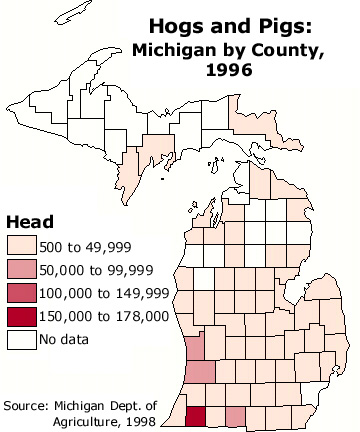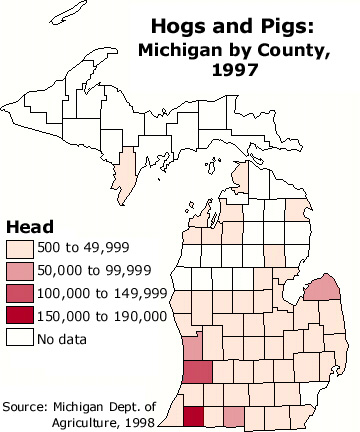PIGS
Pork, the meat from swine or hogs, was widely consumed throughout the ancient world and
the Roman Empire. Swine were first introduced to North America in 1539 when Hernando de
Soto brought 13 to the Florida mainland. Most of the swine in the United States are
produced in the Midwestern states, including Nebraska, Iowa and Illinois. Worldwide, China
is the country that produces the most hogs.
A female pig is called a gilt. After she has borne a litter she is called a sow. A
neutered male is a barrow and the adult male is a boar. The offspring of a male boar and a
female sow are called piglets, or just pigs.
Swine are sold at market when they weigh from 230 to 260 pounds and are about five to six
months of age. Some gilts are usually kept in the herd for breeding to produce the next
generation of pigs. Swine have a digestive system similar to humans. This is different
from ruminent animals such as cattle (see Beef Cattle) which can
eat forages or grasses. Pigs can only digest feed such as corn and soymeal which is ground
into small particles.
In addition to meat, other products or by-products come from swine. These include insulin
for the regulation of diabetes; valves for human heart surgery; suede for shoes and
clothing; and gelatin for many food and non-food uses. Swine by-products are also
important parts of such products as water filters, insulation, rubber, antifreeze, certain
plastics, floor waxes, crayons, chalk, adhesives and fertilizer.


Pig (pork) production is widelay scattered across the state, as many framers keep a few hogs for personal use of for sale. However, in Cass County, production of pork is highly concentrated and very important. Here, hog farms are quite common. However, a growing problem in the county centers around the hog manure, which infiltrates rapidly through the sandy soils and is contaminating groundwater supplies with nitrates.
Source: Unknown
Source: Unknown
This material has been compiled for educational use only, and may not be reproduced without permission. One copy may be printed for personal use. Please contact Randall Schaetzl (soils@msu.edu) for more information or permissions.